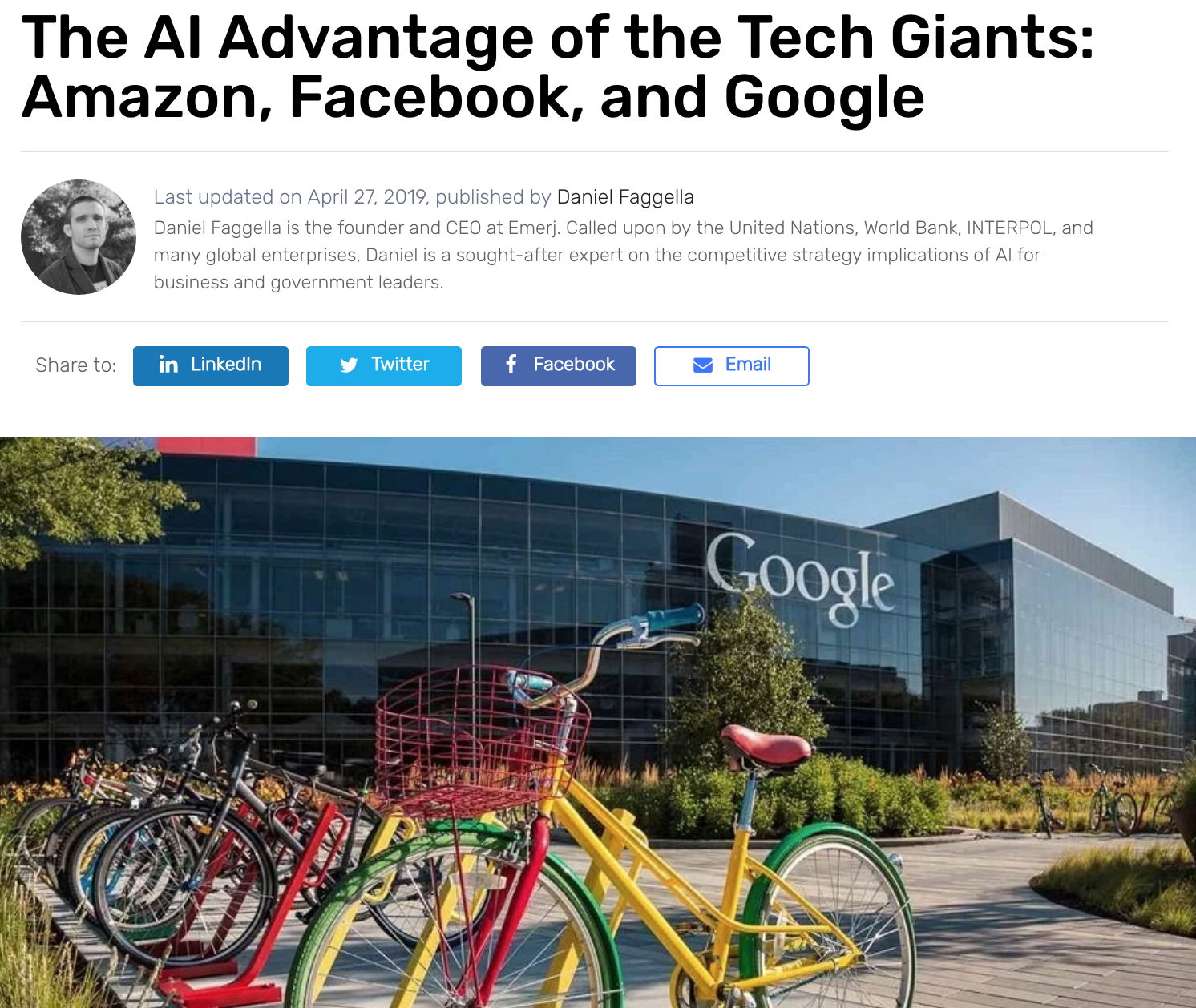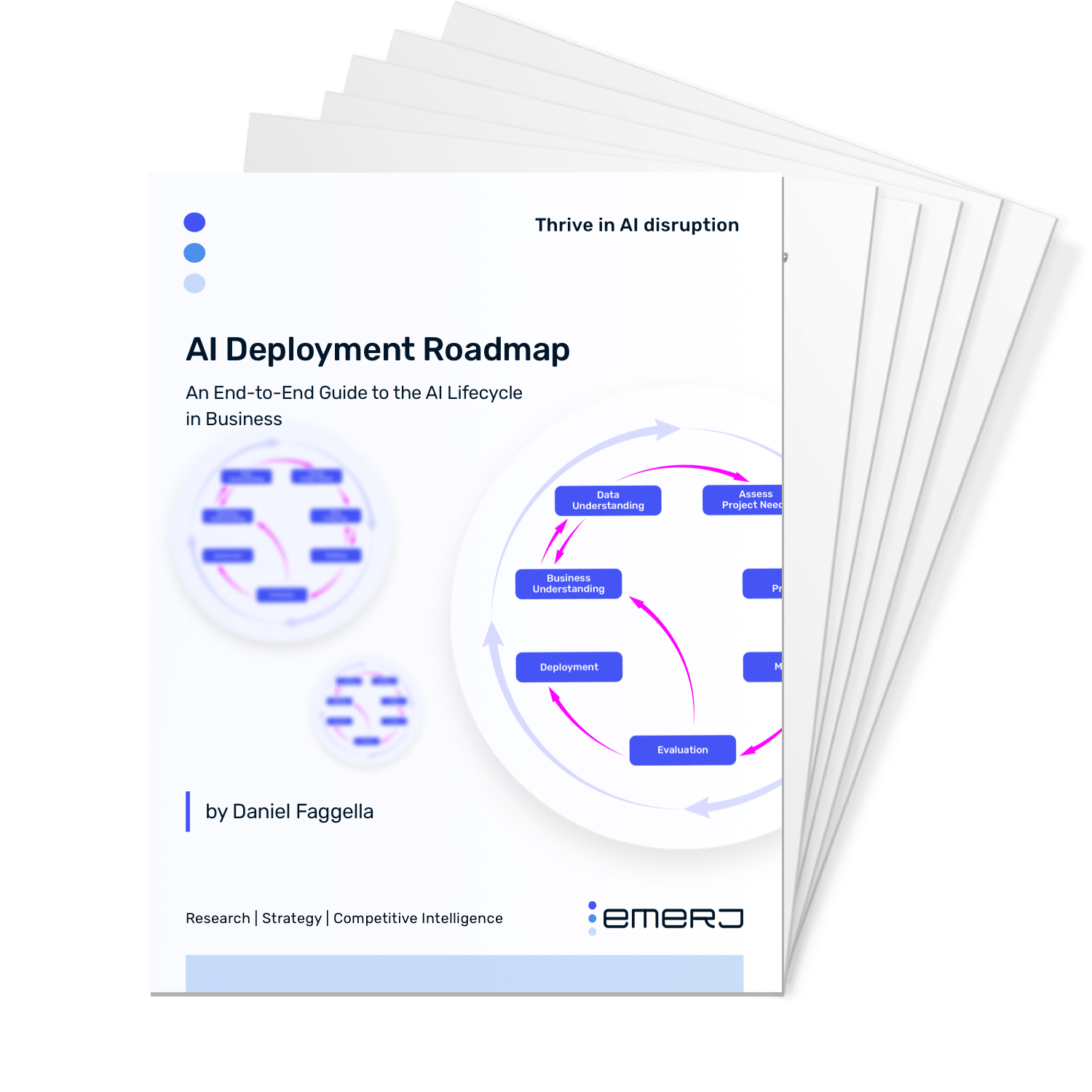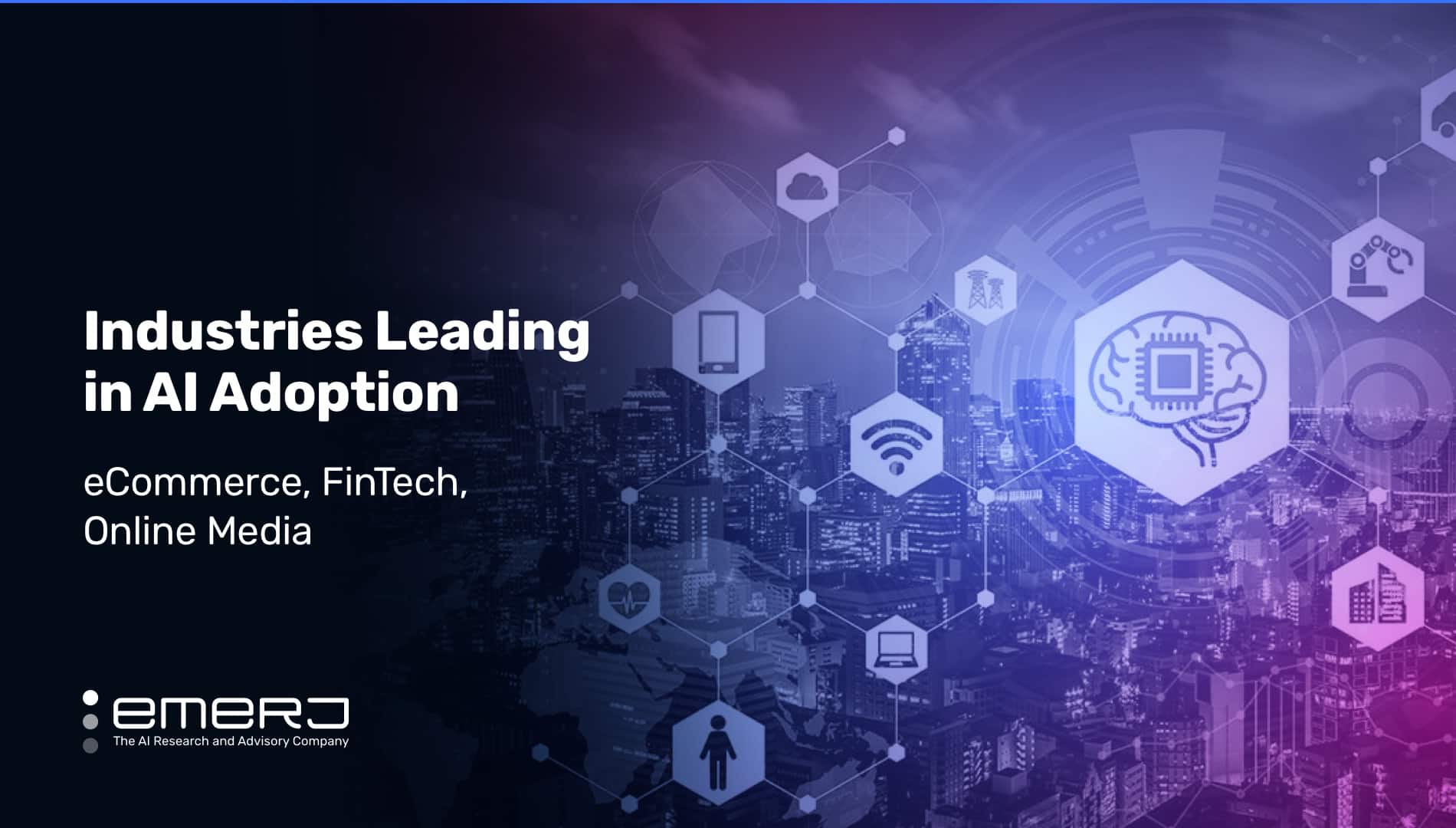This article was a request from one of our Catalyst members. The Catalyst Advisory Program is an application-only coaching program for AI consultants and service providers. The program involves one-to-one advisory, weekly group Q-and-A with other Catalyst members, and a series of proprietary resources and frameworks to land more AI business, and deliver more value with AI projects. Learn more at emerj.com/catalyst.
We frequently cover AI use-cases and transformations in older, established sectors like banking and life sciences. While it’s important to cover the transformation of legacy sectors, it’s also important to get an understanding of which emerging industries are adopting artificial intelligence fastest.
This week we lay out some of the reasons why eCommerce, FinTech, and Online Media are leading in true AI deployments – and how larger or older firms can improve their own innovation speed by taking lessons from these AI-leading industries.
To be clear, what we’re covering in this article is not the industries spending most on AI. Instead, we’re covering the industries who – pound for pound – have among the highest density of actual AI deployments in their business.
In this article we’ll explore:
- A breakdown of eCommerce, FinTech, and Online Media
- The common factors that have allowed these sectors to adopt AI so rapidly
- What enterprise leaders can learn from these emerging digital sectors
For each industry, we’ll provide a set of representative AI use-case-oriented articles and expert interviews to provide the reader with additional context to explore.
We’ll begin with a breakdown of the industries themselves:
Industries Leading in Actual AI Deployment
1. eCommerce
Native e-commerce companies include Amazon and Wayfair, while Walmart transitioned to it, but it is now so big that they can be in the mix as well. Alibaba and Taobao in China are major players – and India has its own batch of burgeoning eCommerce.
Because eCommerce is native online, it has a distinct advantage over brick-and-mortar stores in using AI to track customer behavior. For example, if a customer walks into Target, you will be able to document what they actually buy at checkout. However, you will have a hard time tracking where the customer goes, what they look at and pick up, how long they stayed in the store, and what they ultimately decide not to buy. You will also not be able to infer easily how coupons and reward cards figure into the decision-buying mix.
It is not impossible to track these behaviors, but you will need to install an extremely powerful computer vision system to do it – and these applications are currently nascent at best. The magnitude of power required to track all these disparate behaviors of all the customers that come into a reasonably sized retail store is frankly not yet available.
That technology is available and maximized for online stores, whether they are native eCommerce or transitioned.
Amazon, for example, tracks every click, page turn, category browsed, added or removed item, returned item, payment method, and second spent on the site. The company puts the data gathered to good use when the customer returns to the site by making recommendations, and even when the customer is off-page through targeted ads on social media, browsers, and emails. Being digital-first, and having customers in a “virtual world” (not a complex and hard-to-track physical world) give eCommerce firms a distinct advantage.
Related Emerj Interviews:
Mahmoud Arram, CTO and Founder of Bluecore, an AI-based eCommerce vendor with over $113MM in venture funds raised.
Sumit Borar, Senior Director of Data Sciences and Engineering at Myntra, one of India’s largest eCommerce sites.
Related Emerj Articles:
- Big Data Analytics in eCommerce – Data Platforms and Artificial Intelligence
- Artificial Intelligence in eCommerce – Comparing the Top 5 Largest Firms
- Crowdsourced Search Relevance for eCommerce and Online Retail
2. Online Media
Online media is similar to eCommerce in that it is a digital native and in terms of how it uses AI to gather data. Most people that use the internet understand that some type of tracking is going on when you go on social media such as Facebook or Twitter. Some legacy media outlets also use AI (example: WSJ’s dynamic paywall), but pound-for-pound they aren’t able to leverage it to the same extent (i.e. to generate benefits in as many areas of their business) as pure-play online media firms.
However, the case of Reddit is probably the most interesting example of online media use of AI. Reddit has an engineering culture and capacity to leverage AI at scale, and there’s been some coverage of their AI being used to improve their search function – a common application in media. I would not be surprised if they are using AI to pick up on fraud and fake accounts, cut down on spam, and generally monitor their users for use of dangerous language, inciting violence, and things of that nature.
Related Emerj Interviews:
Dr. Miguel Martinez, Chief Data Scientist and Co-founder at Signal Media
Related Emerj Articles:
- AI in Movies, Entertainment, and Visual Media – 5 Current Use-Cases
- Machine Vision for Advertising – Possibilities in Social and Online Media
- AI for Social Media Censorship – How it Works at Facebook, YouTube, and Twitter
3. Fintech
The third industry would be native FinTech companies, namely those born into FinTech and not part of an existing finance gaint like HSBC. Native FinTech companies would include financial firms such as Stripe, TransferWire, Braintree, Robinhood, or others.
FinTech has the good fortune of being a digital-first sector, and also an extremely well-funded one. FinTech firms are able to leverage AI for applications like payment fraud and other finance-specific use-cases, but they can also leverage AI to improve their app retention, to improve in-app recommendations, and more.
Related Emerj Interviews:
Sergey Gribov, Partner at Flint Capital
Rob Delaney, CEO at Infinia ML, Director at Carrick Capital Partners
Related Emerj Articles:
- AI Transparency in Finance – Understanding the Black Box
- The Future of Banking – AI, Fintech, and How Banks Can Survive Disruption
- AI in Fintech – Current Applications and Use Cases
Factors that Bodsse Well for True AI Adoption
While there might be a dozen factors that give new, digitally-native industries an AI advantage – we’ll cover just four factors that we believe are among the most important reasons why eCommerce, online media, and fintech are so relatively advanced in AI deployments.

Digitally Native Leadership
If you are a native e-commerce company, for example, this means you started as an internet-based or digital business with little by way of legacy IT systems and mindsets and with digitally native leadership.
Digital natives that feel comfortable using disruptive technologies such as AI would run it off the bat.
By contrast, non-digital natives that still do not use email run many multi-billion dollar insurance companies, so it is not an ideal environment to try to use AI.
Lessons for Legacy Enterprise Leaders:
- Find leadership who already has digital savvy and experience, from within or outside of your firm. A culture of innovation starts at the top.
Data in the DNA
Digital native leadership built their business for the digital age because they tend to have data in their DNA. They are born for the web, so they generally have data infrastructure as part of the company set up, especially if they were set up in the last 10 years. Company founders consider the strategic and productive use of data from the beginning, and often set up data infrastructure in a mature way to some degree.
We refer to executive AI fluency (i.e. the ability for leadership to understand AI conceptually, and know where and how it can deliver value in their firm) as the lynchpin for AI project success. eCommerce firms naturally have an advantage, as their leadership has probably had to consider the critical role of both digital and data from the very beginning.
Lessons for Legacy Enterprise Leaders:
- Consciously focus on developing AI fluency. This is easy enough with heads of innovation and heads of strategy (many of whom follow publications like Emerj actively), but for the C-suite, this usually involves carefully selecting and moving forward on actual projects. See our AI Catalyst Manifesto article for a deeper understanding on how AI projects can and should level up AI fluency.
Virtual Worlds
These companies also operate in virtual worlds in which data is easy to leverage and transactions operate in clean virtual worlds. This means that it does away with all the complex and unpredictable issues that happen when you try to apply AI to physical trucks driving around Canada or to actual oil pipes out in the middle of the ocean because they do not happen in virtual worlds.
For example, if you put a temperature sensor on a truck and it falls off the truck producing a reading of minus 10 degrees or it is next to the muffler producing a reading of 100 degrees, then neither would be reliable data to train AI. In virtual worlds, all the variables are controlled and known, making it easier to train algorithms.
Virtual worlds are the best worlds to operate AI because the ground truth is reliable. That is not to say that there should be no effort to apply AI technology in the real world, but it is certainly easier to train AI in virtual worlds.
Lessons for Legacy Enterprise Leaders:
- Consider your most important and reliable and virtual data streams. Which of them might help you create a genuine AI advantage (a “proprietary data plume” in the words of venture investor Ben Narasin)?

Venture Funding
Lastly, these companies benefit from venture funding, so they often have the equity to do exciting projects to attract and retain the best AI talent aside from having the funds for being able to recruit them in the first place.
We did an interview with Equifax Principal Data Scientist and Senior Director Dr. Rajkumar Bondugula about the evolution of the dynamics, composition, and requirements of the data science team over the years.
The gist of the interview was that data scientists are more willing to join and stick around when the company is moving fast with AI, data is in the DNA, and the leadership is digitally savvy because they know they are going into an active space and actually going to be working on interesting problems. You can try to offer a data scientist a salary that is 15% more than Google, but not to do anything exciting or interesting, he or she is going to quit.
Venture money allows them to attract and retain talent because this allows them to build more of the right kind of digitally native leadership and technical skills. In addition, venture capital funding also lets them experiment with different business models and different nascent AI techniques or approaches in many AI use cases.
What does this mean? If we think about the totality of the possibility space of AI, most AI use cases are nascent or emerging. However, even proven AI use cases are still quite experimental in terms of whether they are going to work for any particular business. Venture money allows a company to experiment with risky ideas, develop Critical Capabilities, and create a culture of iteration.
Lessons for Legacy Enterprise Leaders:
- When it comes to AI talent, most firms cannot compete on salary alone. Consider the unique opportunities that your firm offers (company purpose, specific kinds of problems, etc), and ensure that you have enough data access and fluency among leadership to be able to not just keep data scientists “busy,” but to empower them to work hard on the most important opportunity areas in your firm.
- Create a “portfolio approach” for AI projects, even without venture funding. Consider AI projects as venture-like investments: Carefully selected, but we’re not counting on them all working out – we’re counting on some portion of them to work out (i.e. deliver ROI, move us closer to transformation). You don’t need a VC budget to take an investment mindset and begin to shift culture.


















